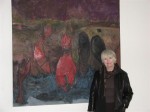Judith Ann ponders Impressionism
May, 2011: I’m in Kansas City, celebrating spring while standing in front of three Monet Water Lilies, re-united for a blockbuster exhibition
at the splendid Nelson-Atkins Museum of Art. I swim among the luscious, languid colors, in a room featuring a few banquettes shaped like lily pads. I surface drenched in Impressionism.
October, 2011: I’m in the Baker/Rowland galleries at the Milwaukee Art Museum, where Impressionism: Masterworks on Paper, is installed until Jan. 8. It’s primarily about Impressionist and Post Impressionist drawing, though a few paintings are included to show the connection between the two disciplines. It’s designed to level the playing field, to give master draftsmen a chance to score against blockbuster works such as those of the aforementioned Monet, the chap who unleashed Impressionism when he exhibited his 1872 painting, Impression, soleil levant (Impression, Sunrise).
I study Sunset on the Beach, by Eugene Boudin, adjusting my bi-focals (newly polished) to better see what’s in front of me. But my biases are along for the ride. Do I see through a glass darkly? For example, I’m inclined to associate Impressionism with grey-hairs taking tea while perched on chintz covered couches. Then I remember that these works were considered avant-garde in the 19th century.
Renoir’s Bathers with Crab is included, as the pay-off for a Carnegie Museum of Art wager. When the Pack beat the Steelers in Super Bowl XLV, to the victor went the spoils. That would be MAM. But will this painting, one of the few among numerous drawings, be enough to bring out the Cheeseheads? (And does the exhibition really need the Packers’ Wayne Larrivee to lend credence to the event?)
Art speaks for itself. Or should. Consider this from writer Joyce Carol Oates, words that make me wonder why I’m standing here poised to be an “art critic:”
“Only when the critic is patiently objective, willing to set aside his or her ‘feelings’ for awhile, and attempt to describe the work objectively, is criticism legitimate. At other times it is illegitimate, but it can be very interesting nonetheless…” (The Journal of Joyce Carol Oates, 1973-1982)
Yes, I’m the illegitimate critic, unable to set aside my feelings, like the masterful art critic.
Peter Schjeldahl, who is his New Yorker magazine October 17 review (Bare Naked Ladies) homes in on Degas’s sex drive (sporadic) and beyond, to the connection between drawing and Impressionism.
“Degas seems to create his women as if they were all Eves, even a chubby prostitute scratching her buttocks…”
And according to Mr. Schjeldahl, there stands God, a.k.a. Degas.
Is it a coincidence that this is the way I interpret Renoir, which is to say, all flesh and no fire? Beef aplenty but no carnal desire? As seen through the eyes of male painters, perhaps desire is visible somewhere in Renoir’s mix.
Still, I’m having trouble making the historical leap back into time when these works were considered modern. I yearn to be Owen Wilson in Midnight in Paris, mingling magically with the past. On Oct. 27 at 6:15 p.m. at MAM, Jennifer Thompson, the Philadelphia Museum of Art Associate Curator of European Painting and Sculpture before 1900, will speak and, I hope, cast new light on Bathers. I’ll be there. Perhaps she can solve the nagging mystery in my head: Isn’t there another Renoir featuring bathers and a crab, called I Get Crabby when Playing with Bathers?
Art
-
It’s Not Just About the Holidays
 Dec 3rd, 2024 by Annie Raab
Dec 3rd, 2024 by Annie Raab
-
After The Election Is Over
 Nov 6th, 2024 by Annie Raab
Nov 6th, 2024 by Annie Raab
-
The Spirit of Milwaukee
 Aug 30th, 2024 by Annie Raab
Aug 30th, 2024 by Annie Raab
























